10 Multicultural Resources or Books 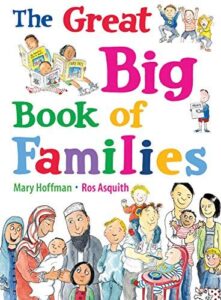
- The Great Big Book of Families discusses the reality that not all families look the same by featuring a number of diverse family structures, including families with a mom and dad, a single parent, parents of the same gender, grandparents, and foster or adoptive parents. The book also includes families with many children and no children. Additionally, the book explores other social issues that impact families, including housing and homelessness, food, clothing, and employment. The book concludes by asking students to consider their own family trees and what makes their family unique (Hoffman & Asquith, 2011). There are a number of I could use this book to foster students’ critical consciousness in my future classroom. For example, I could ask guiding questions, including “What does the word family mean?,” “Do you see a family that looks like yours?,” “How are the families different from yours?,” and “How are they the same?” This classroom discussion would expose students to diverse family structures in order to promote acceptance and respect for others. Additionally, students could be invited to create a personal family tree featuring important members of their own families. These family trees could then be displayed in the classroom to build community and make every student feel proud of their unique family.
Hoffman, M., & Asquith, R. (2011). The great big book of families. New York: Dial Books for Young Readers.
 2. Marisol McDonald Doesn’t Match features a biracial and bicultural family. Marisol’s father is Scottish-American and her mother is Peruvian-American, so Marisol grows up in a bilingual household. The book shows Marisol’s rejection of pressure to conform as she realizes she must be true to her “mismatched” self and feel proud of who she is (Brown & Palacios, 2011). This book could be used to foster students’ critical consciousness by promoting awareness and acceptance for bilingual and biracial individuals. In my future classroom, I can read this book with students and ask a number of discussion questions like “Who are the people in Marisol’s family?,” “Why do people say Marisol does not match?,” “Does Marisol enjoy making herself match?,” and “What would you do in Marisol’s situation?” Additionally, I could ask students to interview family members about their cultural heritage and think about how these identities impact their family (food, clothing, languages, holidays, etc.). Students could then share something important to their family’s background/identity to build community and acceptance for diversity.
2. Marisol McDonald Doesn’t Match features a biracial and bicultural family. Marisol’s father is Scottish-American and her mother is Peruvian-American, so Marisol grows up in a bilingual household. The book shows Marisol’s rejection of pressure to conform as she realizes she must be true to her “mismatched” self and feel proud of who she is (Brown & Palacios, 2011). This book could be used to foster students’ critical consciousness by promoting awareness and acceptance for bilingual and biracial individuals. In my future classroom, I can read this book with students and ask a number of discussion questions like “Who are the people in Marisol’s family?,” “Why do people say Marisol does not match?,” “Does Marisol enjoy making herself match?,” and “What would you do in Marisol’s situation?” Additionally, I could ask students to interview family members about their cultural heritage and think about how these identities impact their family (food, clothing, languages, holidays, etc.). Students could then share something important to their family’s background/identity to build community and acceptance for diversity.
Brown, M. & Palacios, S. (2011). Marisol mcdonald doesn’t match / Marisol McDonald no combina. Lee & Low Books, Inc.
https://www.barnesandnoble.com/w/marisol-mcdonald-doesnt-match-marisol-mcdonald-no-combina-monica-brown/1111574491 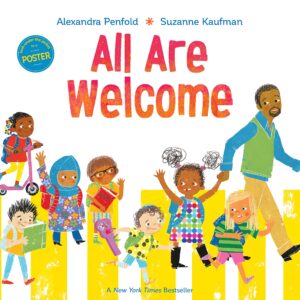
3. All Are Welcome is a children’s book that emphasizes themes of diversity and inclusion. This book features a number of school children and their interactions throughout the day. Whether the children are in the classroom, on the playground, or in the lunchroom, the book stressed that all students are welcomed and accepted. Additionally, the book emphasizes that all students are part of a community and diversity is a source of strength (Penfold & Kaufman, 2018). This book could be used to advance critical consciousness in a number of ways. As my students read the book, I can ask them to consider how people are different and how people are all the same. Also, I can encourage empathy by asking students how they feel when they are included and how being excluded makes them feel. I will emphasize the reality that the classroom is a welcoming community where every individual should feel accepted and proud of their unique identities.
Penfold, A. & Kaufman, S. (2018). All are welcome. Random House Children’s Books.
https://www.amazon.com/All-Are-Welcome-Alexandra-Penfold/dp/0525579648
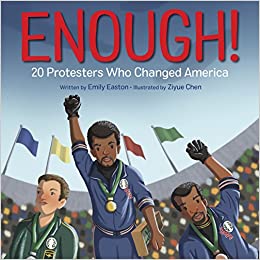 4. Enough! 20 Protesters Who Changed America chronicles the story of a number of American protesters who have made positive changes throughout history due to their activism and concern for promoting equity. For example, the featured activists including those who organized the Boston Tea Party; activists for racial justice including Martin Luther King Jr., Harriet Tubman, and Colin Kaepernick; and Jazz Jennings, a proponent of transgender rights (Easton & Chen, 2018). As I explore this work in my future classroom, I can ask students to consider the motivations for each of these activists and the positive changes made as a result of their efforts. Students can see that there is a long history of activism, and people continue to advocate for a more equitable society today. Students can also consider how they can be activists in their own communities. For example, I can ask students to make posters supporting an issue students care about, including topics like racial justice, transgender rights, or other aspects of inclusivity to place throughout the school. I could also ask students to work in groups to research additional information about an activist featured in the book and present this information in a poster or piece of writing.
4. Enough! 20 Protesters Who Changed America chronicles the story of a number of American protesters who have made positive changes throughout history due to their activism and concern for promoting equity. For example, the featured activists including those who organized the Boston Tea Party; activists for racial justice including Martin Luther King Jr., Harriet Tubman, and Colin Kaepernick; and Jazz Jennings, a proponent of transgender rights (Easton & Chen, 2018). As I explore this work in my future classroom, I can ask students to consider the motivations for each of these activists and the positive changes made as a result of their efforts. Students can see that there is a long history of activism, and people continue to advocate for a more equitable society today. Students can also consider how they can be activists in their own communities. For example, I can ask students to make posters supporting an issue students care about, including topics like racial justice, transgender rights, or other aspects of inclusivity to place throughout the school. I could also ask students to work in groups to research additional information about an activist featured in the book and present this information in a poster or piece of writing.
Easton, E. & Chen, Z. (2018). Enough! 20 protesters who changed america. Random House Children’s Books
https://www.amazon.com/Enough-Protesters-Who-Changed-America/dp/1984831976
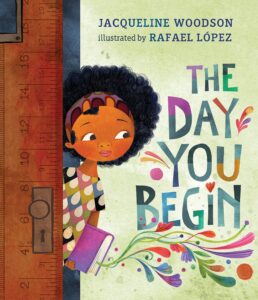 5. The Day You Begin chronicles the story of a girl names Angela who feels out of place when all her classmates talk about their fun summer plans because she spent the summer taking care of her sister at home. The book emphasizes the reality that, although we are different, we can celebrate differences and find comfort in what we have in common (Woodson & López, 2018). This book can be used to promote critical consciousness in my future classroom because I can use it to start discussions about what students can do to make sure everyone feels accepted, both inside the classroom and throughout students’ communities. Additionally, I can ask students to recall times they have felt out of place and share their ideas about why it is important to make everyone feel welcome. I can ask students to write a narrative story or draw pictures to represent a time they felt excluded or a time they made someone feel accepted.
5. The Day You Begin chronicles the story of a girl names Angela who feels out of place when all her classmates talk about their fun summer plans because she spent the summer taking care of her sister at home. The book emphasizes the reality that, although we are different, we can celebrate differences and find comfort in what we have in common (Woodson & López, 2018). This book can be used to promote critical consciousness in my future classroom because I can use it to start discussions about what students can do to make sure everyone feels accepted, both inside the classroom and throughout students’ communities. Additionally, I can ask students to recall times they have felt out of place and share their ideas about why it is important to make everyone feel welcome. I can ask students to write a narrative story or draw pictures to represent a time they felt excluded or a time they made someone feel accepted.
Woodson, J. & López, R. (2018) The day you begin. Penguin Young Readers Group.
https://www.amazon.com/Day-You-Begin-Jacqueline-Woodson/dp/0399246533 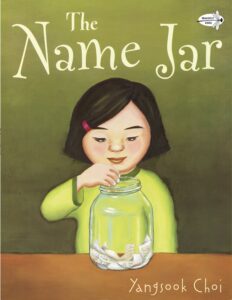
- The Name Jar details the story of Unhei, a new student who has recently moved to the United States from Korea. Because she is nervous about fitting in and worries that American children will be unable to pronounce her name, Unhei avoids introducing herself and says she will pick a name the following week. Fascinated by this decision, her classmates decide to help her by filling a name jar with suggestions. Ultimately though, a friend helps Unhei realize the beauty of her own name. Unhei helps everyone pronounce her name correctly, Yoon-Hey (Choi, 2003). I could use this multicultural book in my future classroom in a number of ways. For example, I could have students consider how it feels to have their name mispronounced and why it is important to pronounce other individuals’ names correctly. I could also demonstrate the importance of individual identities by encouraging my students to explore and share the unique meanings behind their own names. I could also involve families by having students ask their parents or guardians why they were given their name and the meaning behind it.
Choi, Y. (2003). Name jar. Random House International.
 7. Sumo Joe is a book about Sumo Joe and his friends who enjoy pretending to be sumo wrestlers. In addition to making mawashi belts and practicing drills like teppo in their homemade dohyo ring, this group has an important rule: no girls allowed. However, when Sumo Joe’s little sister wants to join, he is torn between upholding the rules of the group and being a good older brother (Wenjen & Iwata, 2019). I could use this multicultural book in my future classroom to promote acceptance. For example, I could have students consider how Sumo Joe’s sister felt being excluded and why it is important to be welcoming and inclusive to everyone. I could also encourage my students to discuss and share important hobbies or traditions that are important to each student’s family or culture.
7. Sumo Joe is a book about Sumo Joe and his friends who enjoy pretending to be sumo wrestlers. In addition to making mawashi belts and practicing drills like teppo in their homemade dohyo ring, this group has an important rule: no girls allowed. However, when Sumo Joe’s little sister wants to join, he is torn between upholding the rules of the group and being a good older brother (Wenjen & Iwata, 2019). I could use this multicultural book in my future classroom to promote acceptance. For example, I could have students consider how Sumo Joe’s sister felt being excluded and why it is important to be welcoming and inclusive to everyone. I could also encourage my students to discuss and share important hobbies or traditions that are important to each student’s family or culture.
Wenjen, M., & Iwata, N. (2019). Sumo Joe. New York: Lee & Low Books.
https://www.amazon.com/Sumo-Joe-Mia-Wenjen/dp/1620148021 
8. The Colors of Us is a book about a seven-year-old girl named Lena who is going to paint a picture of herself and wants to use brown paint for her skin. When she takes a walk through the neighborhood, however, she recognizes that people come in many different colors. She recognizes many different shades of brown while also appreciating the similarities between all people (Katz, 1999). I could use this multicultural book in my classroom to promote acceptance of people who might look different from oneself. I could also use this book to encourage students to feel proud of their unique identities. For example, I could provide a variety of art materials and colors and have students create a self-portrait to highlight important identities and characteristics they are proud of.
Katz, K. (1999). The colors of us. New York: Henry Holt and Company.
https://www.amazon.com/Colors-Us-Karen-Katz/dp/0805071636
 9. Last Stop on Market Street explores the life of CJ and his grandma as they ride the bus on Sunday after church. CJ asks a lot of questions about why his family does not own a car like his friend Colby, why he does not have an iPod like other children at school, and why he always has to get off at the dirty part of town. In response to these questions, CJ’s grandma offers encouragement and helps CJ feel proud of his home and see the wonder in the world around him (Peña & Robinson, 2015). I could use this multicultural book in my classroom to build critical consciousness in my students. For example, I could have students consider the systems of inequality that promote income gaps and brainstorm possible solutions for improving these situations. Additionally, I could encourage students to share things they love about their homes and help students recognize that they should feel proud of where they come from.
9. Last Stop on Market Street explores the life of CJ and his grandma as they ride the bus on Sunday after church. CJ asks a lot of questions about why his family does not own a car like his friend Colby, why he does not have an iPod like other children at school, and why he always has to get off at the dirty part of town. In response to these questions, CJ’s grandma offers encouragement and helps CJ feel proud of his home and see the wonder in the world around him (Peña & Robinson, 2015). I could use this multicultural book in my classroom to build critical consciousness in my students. For example, I could have students consider the systems of inequality that promote income gaps and brainstorm possible solutions for improving these situations. Additionally, I could encourage students to share things they love about their homes and help students recognize that they should feel proud of where they come from.
Peña, M. D., & Robinson, C. (2015). Last stop on Market Street. New York, NY: G.P. Putnam’s Sons, an imprint of Penguin Group (USA).
https://www.amazon.com/Last-Stop-Market-Street-Matt/dp/0399257748
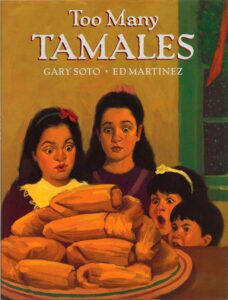 10.Too Many Tamales explores the life of a girl named Maria as she prepares for tamales for Christmas dinner. On Christmas Eve, Maria’s favorite cousins come over to help with the cooking. When Maria’s mom leaves the kitchen, Maria decides to try on her mother’s ring and loses it in the large batch of tamales. As a result, Maria and her cousins decide they must eat their way out of trouble (Soto & Martinez, 1993). I could incorporate this book in my classroom to begin discussions about cultural foods and holidays. In addition to discussing tamales and Christmas, I could ask students to share information about a holiday that is important to their family. I could also ask students to share their favorite foods associated with these holidays. Students could learn more about their classmates and recognize the value in differing cultures and traditions.
10.Too Many Tamales explores the life of a girl named Maria as she prepares for tamales for Christmas dinner. On Christmas Eve, Maria’s favorite cousins come over to help with the cooking. When Maria’s mom leaves the kitchen, Maria decides to try on her mother’s ring and loses it in the large batch of tamales. As a result, Maria and her cousins decide they must eat their way out of trouble (Soto & Martinez, 1993). I could incorporate this book in my classroom to begin discussions about cultural foods and holidays. In addition to discussing tamales and Christmas, I could ask students to share information about a holiday that is important to their family. I could also ask students to share their favorite foods associated with these holidays. Students could learn more about their classmates and recognize the value in differing cultures and traditions.
Soto, G., & Martinez, E. (1993). Too many tamales. New York: Putnam’s Sons.
https://www.amazon.com/Too-Many-Tamales-Gary-Soto/dp/0698114124
5 Professional Development Opportunities
- The podcasts listed under the professional development section of the Teaching Tolerance website provide opportunities for current and future educators to explore topics including teaching hard history, queer America, the mind online, and other related resources. In my future teaching, I can refer to these podcasts to gain additional information and perspectives on topics before I teach them. For example, I could listen to the podcast on the Civil Rights Movement before presenting this topic in my classroom. The podcast format of these professional development opportunities makes them highly accessible and something I could incorporate into the spare time I have throughout my day. For example, I could listen to one of these podcasts while I drive or exercise.
Podcasts. (2020, August 11). Teaching Tolerance. https://www.tolerance.org/podcasts
- The Teaching Tolerance website also provides information about a number of professional development workshops for current K–12 classroom teachers, administrators, counselors, and anyone who coaches classroom teachers and administrators. These workshops are 90-minute sessions delivered over Zoom that cost $15 to attend. The workshops they have recently offered include Addressing Inequities at School, Unpacking the Teaching Tolerance Social Justice Standards, and Speak Up At School. To support my future teaching, I could attend these workshops to learn new skills and strategies for teaching a wide variety of concepts. I could also encourage other members of my school’s faculty and staff to attend these professional development opportunities to promote more inclusive and consistent teaching and expectations for students.
Workshops. (2020, June 26). Teaching Tolerance. https://www.tolerance.org/professional- development/workshops
- The Global Family Research Project provides access to an archive of many useful resources for teaching and preparing future educators. For example, this website offers many useful resources and supporting research for building and evaluating family, school, and community engagement practices, programs, and policies; strengthening professional and organizational development; and creating more equitable learning environments and supports for students and their families. I can use the resources on this website to prepare for future teaching and gain additional support after I begin teaching. For example, I could review the guide on strategies for parent-teacher conferences before I hold my first conference as a first-year teacher.
Archive. (n.d.). https://globalfrp.org/Archive
- EdChange.org offers an assortment of resources for educators. The Awareness Activities collection provides numerous engaging ideas and activities to introduce diversity at the beginning of the school year. These activity guides include a number of ice breakers as well as introspective activities that explore topics like multiculturalism, equity, and personal identity. Additionally, the resource offers strategies and preparation tips for beginning the school year and engaging students in understanding diversity and related concepts. I can use this resource to plan activities for my future teaching. Additionally, this resource will help me make sure I am addressing multicultural topics appropriately and engaging my students in student-to-student discourse throughout the year.
Equity, anti-bias, & diversity activities & exercises. (n.d.). EdChange – Advocating Equity in Schools and Society. https://www.edchange.org/multicultural/activityarch.html
- Scholastic’s lesson plans and resources for multiculturalism and diversity offers many professional development opportunities that will be helpful throughout my career as a teacher. This website provides a number of guidelines and suggestions for topics like teaching diversity, helping children develop a sense of identity, teaching difficult race-related issues, and working with children and families from many cultures. In addition to these guides, the website also provides many sample lesson plans. Some of these lesson plans include Internet Field Trips, Games Around the World, Culture and Change: Black History in America, Celebrate Hispanic Heritage, and Immigration: Stories of Yesterday and Today. In my future teaching, I can refer to these lesson plans as a guide or starting point for bringing topics related to multiculturalism and diversity into my future classrooms.
Multiculturalism and diversity. (n.d.). Scholastic | Books for Kids | Parent & Teacher Resources. https://www.scholastic.com/teachers/lesson-plans/teaching-content/multiculturalism-and-diversity/